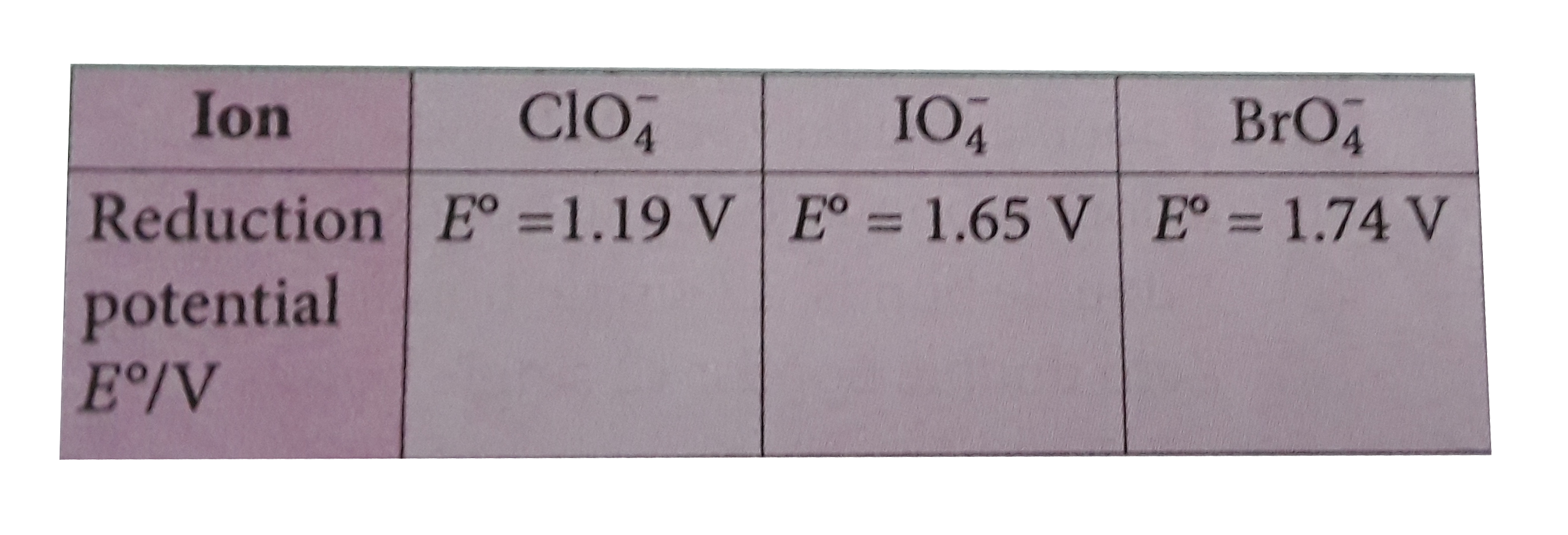Reduction potentials of some ions are given below. Arrange them in decreasing order of oxidising power.
Ion CiO−4 IO−4 BrO−4
Reduction EΘ=1.19V EΘ=1.65V EΘ=1.74
potential EΘ/V
ClO−4>IO−4>BrO−4
IO−4>BrO−4>ClO−4
BrO−4>IO−4>ClO−4
BrO−4>ClO−4>IO−4
The correct Answer is:D
When the mixture of noble gas is cooled in a coconut bulb at 173K then Ar, Kr and Xe and adsorbed on charcoal while He and Ne are not adsorbed .
Topper's Solved these Questions
- P-BLOCK ELEMENTS Book:MHTCET PREVIOUS YEAR PAPERS AND PRACTICE PAPERSChapter:P-BLOCK ELEMENTS Exercise:MHT CET corner
Explore 43 Videos
- P-BLOCK ELEMENTS Book:MHTCET PREVIOUS YEAR PAPERS AND PRACTICE PAPERSChapter:P-BLOCK ELEMENTS Exercise:MHT CET corner
Explore 43 Videos
- ORGANIC COMPOUNDS CONTAINING NITROGEN Book:MHTCET PREVIOUS YEAR PAPERS AND PRACTICE PAPERSChapter:ORGANIC COMPOUNDS CONTAINING NITROGEN Exercise:MHT CET CORNER
Explore 34 Videos
- POLYMERSBook:MHTCET PREVIOUS YEAR PAPERS AND PRACTICE PAPERSChapter:POLYMERSExercise:MHT CET Corner
Explore 15 Videos
Similar Questions
What will be the spontaneous reaction when the following half reactions are combined ?
(i) Fe3++e−→Fe2+ , (ii) MnO−4+8H++5e−→Mn2++4H2O,(EΘ=+1.49V)
What is the value of EΘcell ?
View SolutionArrange in decreasing order of + R power in the given groups
(1) −NH2
(2) −OΘ
(3) −OH
(4) −NHCOCH3
View Solution
Knowledge Check
Reduction potential of some ions are given below. Arrange them in decreasing order of oxidising power.
IonClO−4IO−4BrO−4ReductionEΘEΘ=1.65VEΘ=1.74Vpotential EΘ/VAClO−4>IO−4>BrO−4BIO−4>BrO−4>ClO−4CBrO−4>IO−4>ClO−4DBrO−4>ClO−4>IO−4Reduction potentials of same ions are given below. Arrange them in decreasing order of oxidising power.
IonClO−4IO−4BrO−4Reduction potentialE∘/VE−=1.19VE−=1.65VE−=1.74VAClO–4>IO–4>BrO–4BIO−4>BrO−4>ClO−4CBrO−4>IO−4>ClO−4DBrO−4>ClO−4>IO−4Reduction potentials of some ions are given below. Arrange them in decreasing order of oxidising power.
 AClO−4>IO−4>BrO−4BIO−4>BrO−4>ClO−4CBrO−4>IO−4>ClO−4DBrO−4>ClO−4>IO−4
AClO−4>IO−4>BrO−4BIO−4>BrO−4>ClO−4CBrO−4>IO−4>ClO−4DBrO−4>ClO−4>IO−4
The standard electrode potentials of the electodes are given below. Arrange them in decreasin order of ease of oxidations
(1)Electrode −I,E∘=−2.89V(2)Electrode −II,E∘=−0.16V(3)Electrode −III,E∘=0.77V(4)Electrode −IV,E∘=−2.93V(5)Electrode −V,E∘=−1.67V
View SolutionThe standard reduction potentials of 4 elements are given below . Which of the following will be the most suitable oxidising agent ?
I=−3.04V,II=−1.90VIII=0V,IV=1.98V
View SolutionGiven that : I2+2e−→2IΘ, EΘ=0.54V
Br2+2e−→2BrΘ, EΘ=1.69V
Predict which of the following is true .
View SolutionThe standard reduction potentials of 4 clements are given below. Which of the following will be the most suitable reducing agent?
1 -- 3.04 V, II = -1.90 V, III = 0 V, IV = 1.90 V
View SolutionStandard reduction potentials for the half reactions are given below :
F2(g)+2e−→2F−(aq),E∘=+2.85 V
Cl2(g)+2e−→2Cl−(aq),E∘=+1.36 V
Br2(g)+2e−→2Br−(aq),E∘=+1.06 V
I2(g)+2e−→2I−(aq),E∘=+0.53 V
The strongest oxidising and reducing agents respectivity are :
View Solution